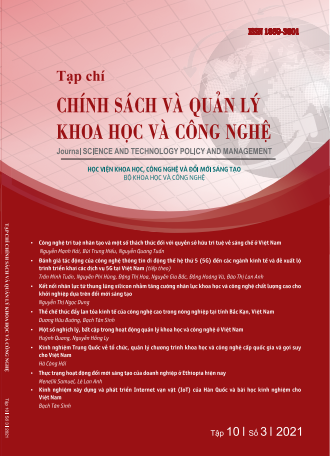Innovation activities of Ethiopian enterprises: current issues and recommendations
Keywords:
Innovation, Technological innovation, Process innovation, Enterprises, EthiopianAbstract
This research analysis of the second Ethiopian national innovation survey conducted for the year 2019. The result of this research provides information about the technological and non-technological innovations status, and the barriers of innovation among Ethiopian enterprises. Based on a list of 300,000 legally registered businesses oriented firms was obtained from different government ministries and organizations, this research’s findings indicate that only 19.4% of the sample enterprises were innovative. Disaggregation of innovation by types shows that the main types of innovation were product innovations, followed by process innovations; where about 96% of the innovative enterprises introduced technological innovations (product and/or process innovations). The innovative firms introduced a total of 686 innovations, out of which 56% were product innovations and 78.6% were technological innovations. The average number of innovations per enterprise was 4.64%.
Code: 21072301
Downloads
References
1. Abramovitz, M., (1989). “Thinking about growth: and other essays on economic growth and welfare”. Cambridge: Cambridge University Press.
2. Cooper, R. G., & Edgett, S. J. (2009). Successful product innovation: a collection of our best. Charleston: Booksurge.
3. EC (European Communities), (2009). Global Governance of Science. Report of the Expert Group on Global Governance of Science.
4. Elshamy, H. (2015). The impact of firm size on innovative activity: An analysis based on Egyptian firm data. International Journal of Business and Technopreneurship, 5, 397-406.
5. EPA. (2006). Environmental policy of Ethiopia. Addis Ababa,Ethiopia.
6. Ertac, S., Gurdal, M.Y. (2012). Deciding to decide: Gender, leadership and risktaking in groups. Journal of Economic Behavior & Organization, 83 (2012) 24- 30 27
7. Fagerberg, J. (1988). International competitiveness. The economic journal, 98(391), 355-374.
8. Freeman, C. (1987), Technology Policy and Economic Performance: Lessons from Japan, Pinter, and London.
9. Gerschenkron, A., (1962). “Economic backwardness in historical perspective: a book of essays”: Harvard University Press.
10. George, S. (1996). Innovation, Firm Size and Market Structure: Schumpeterian Hypotheses and Some New Themes. OECD Economic Studies, (27).
11. Gomes-Casseres, B., Hagedoorn, J., Jaffe, A., 2006. Do alliances promote knowledge flows? Journal of Financial Economics 80 (1), 5-33.
12. Gong, B., Yang, C., (2012). Gender differences in risk attitudes: Field experiments on the matrilineal Mosuo and the patriarchal Yi. Journal of Economic Behavior & Organization, 83 (2012) 59- 65 61.
13. Griffin, A., (1997). PDMA research on new product development practices: updating trends and bench marking practices, The Journal of Product Innovation Management, 14(6) PP: 429-458.
14. Huergo, E., & Jaumandreu, J. (2004). Firms’ age, process innovation and productivity growth. International Journal of Industrial Organization, 22(4), 541-559.
15. Kemp, R. (2000). Technology and Environmental Policy-Innovation effects of past policies and suggestions for improvement. Innovation and the Environment, 1, 35-61.
16. Koen, P. et al. (2002). Fuzzy front end: effective methods, tools and techniques. Wiley, New York, NY.
17. Lall, S., (1992). Technological capabilities and industrialization. World Development 20(2): 165-86.
18. Martínez-Ros, E., & Labeaga, J. M. (2002). The relationship between firm size and innovation activity: a double decision approach. Economics of Innovation and New Technology, 11(1), 35-50.
19. May, C. (2006). World Intellectual Property Organization (WIPO): Resurgence and the Development Agenda. Routledge.
20. MInT. (2012). FDRE Science, Technology and Innovation Policy. Addis Ababa.
21. Moller, L. C. (2015). Ethiopia’s great run: the growth acceleration and how to pace it. Washington, DC: World Bank Group.
22. Mowery, D. C., & Oxley, J. E. (1995). Inward technology transfer and competitiveness: the role of national innovation systems. Cambridge journal of economics, 19(1), 67-93.
23. OECD. (2005). Oslo Manual: guidelines for collecting and interpreting innovation data (3rd Edition ed.). Oslo, Norway: OECD.
24. OECD. (2012). Innovation in the crisis and beyond. OECD Science, Technology and Industry Outlook. Oslo Manual 2018: Guidelines for Collecting, Reporting and Using Data on Innovation, 4th Edition, The Measurement of Scientific, Technological and Innovation Activities, OECD Publishing, Paris/Eurostat, Luxembourg., (last accessed 23.12.2018).
25. Paunov, C. (2012), “The global crisis and firms’ investments in innovation”, Research Policy, Vol. 41, pp. 24-35.
26. Shane, S., 1995, Uncertainty avoidance and the preference for innovation championing roles, Journal of International Business Studies, 26, 47-68.
27. Reitzig, C. (2011). Productivity is not enough: a comparison of interactive and nominal brainstorming groups on idea generation and selection. Journal of Experimental Social Psicology, 42, 244-251.
28. Szirmai, A., (2012). Industrialization as an engine of growth in developing countries, 1950-200. Structural Change and Economic Dynamics 23 (2012) 406- 420.
29. Verspagen, B. (1991). A new empirical approach to catching up or falling behind. Structural Change and Economic Dynamics, 2(2): 359-80.
30. UNESCO, (United Nations Educational, Scientific and Cultural Organization), (2015). UNESCO Science Report: towards 2030.
31. UNSD (United Nations Statistical Division), (2008). The International Standard Industrial Classification of All Economic Activities (ISIC). New York.
Downloads
Published
How to Cite
Issue
Section
License
Authors who publish with this journal agree to the following terms:
- Authors retain copyright and grant the journal right of first publication with the work simultaneously licensed under a Creative Commons Attribution License that allows others to share the work with an acknowledgement of the work's authorship and initial publication in this journal.
- Authors are able to enter into separate, additional contractual arrangements for the non-exclusive distribution of the journal's published version of the work (e.g., post it to an institutional repository or publish it in a book), with an acknowledgement of its initial publication in this journal.
- Authors are permitted and encouraged to post their work online (e.g., in institutional repositories or on their website) prior to and during the submission process, as it can lead to productive exchanges, as well as earlier and greater citation of published work (See The Effect of Open Access).

